ADEPT | Gagauzia 2016 | Presidential 2016 | Elections 2015 | Bashkan 2015 | Gagauzia 2012 | Political Parties
BPO findings on the eve of parliamentary elections
The findings of the Barometer of Public Opinion (BPO) bring a special interest compared with other surveys, as it maintains a constant bloc of questions and the survey develops in a standard methodological framework. The latest BPO was carried out during October 17 — November 7, 2010 on a sample of 1,104 respondents, which corresponds to an error margin of ±3%. The interest for the latest survey is linked to the pre-electoral period, when electoral candidates influence the public opinion.
Social optimism — implicit indicator for eventual electoral preferences
The evolution of social optimism linked to the general perception of the state of things is also important for the implicit assessment of citizens’ support, particularly of those with uncertain political preferences for ruling or opposition parties. The last surveys (August-November 2010) revealed a series of evolutions, generally confirmed by the recent BPO. Given these evolutions, it is normal to make clear the citizens’ perceptions, especially because former authorities which are now in opposition insist on incoherence of the recent BPO.
Hence, Moldovan citizens felt the last decade that their country generally moved and keep moving to a wrong direction. However, Table 1 reveals that the negative perceptions oscillated around 50% in the first half of the last decade. The perceptions worsened in the second half of the decade, oscillating around 60%.
Table 1. Do you think that the country is moving towards a right or wrong direction?
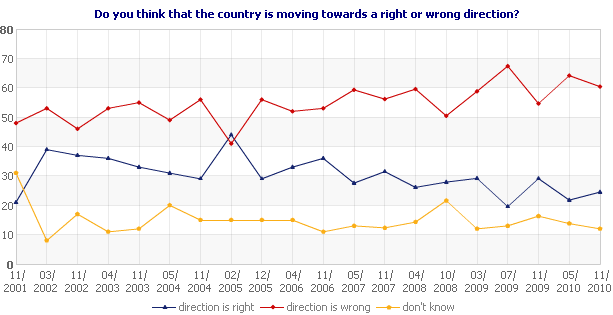
The perceptions have worsened because the Russian Federation embargoed the Moldovan agro-food products, destroying the wine industry, after the Moldovan economy achieved an important growth in the first half of the last decade, particularly due to robust regional economic growths and political stability, and therefore, fuel prices increased successively and attracted chain prise rises for other products. Finally, the eight-year rule of the Party of Communists of the Republic of Moldova (PCRM) culminated with a deep political crisis superposed to the imported economic-financial crisis. Therefore, it is not a surprise that the general perception of the situation is that revealed by BPO. However, it is worth noting that the perceptions are improving after the Alliance for European Integration (AEI) took over the rule. This is the first indicator that the social optimism could turn in principle into political support.
The general perception of economic situation in our country oscillates around figures achieved before the AEI took over the rule in 2009. Table 2 reveals that AEI succeeded at least to maintain a stable situation, which is very important if taking into account the fact that the governing was taken over during an acute financial-economic crisis.
Table 2. How content you are with the present economic situation in Moldova?
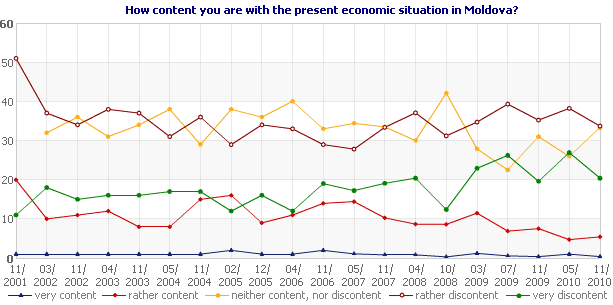
The perception that the economic situation has stabilised the last year is revealed by Table 3, which indicates that the number of respondents saying that the economic situation last year was worse decreased by about 20%, while the number of those feeling that the situation is better increased below statistical error.
Table 3. What do you think about economic situation in the Republic of Moldova compared with last year?
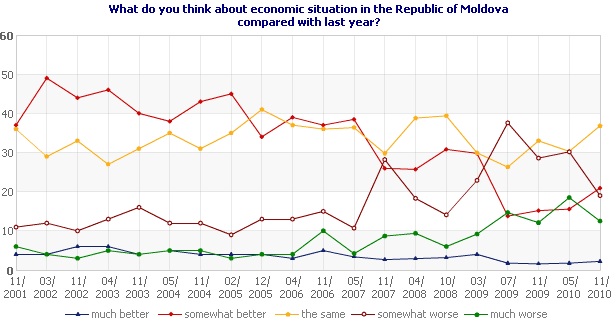
The rise of the social optimism is clearly revealed by Table 4, which also indicates an important decline in the number of respondents who fear that the economic situation will worse and much worse next year. On the other hand, the number of optimistic respondents has increased, exceeding a little the percent indicated before the April 5, 2009 elections.
Table 4. How do you see the economic situation in the Republic of Moldova next year in comparison with the present economic situation?
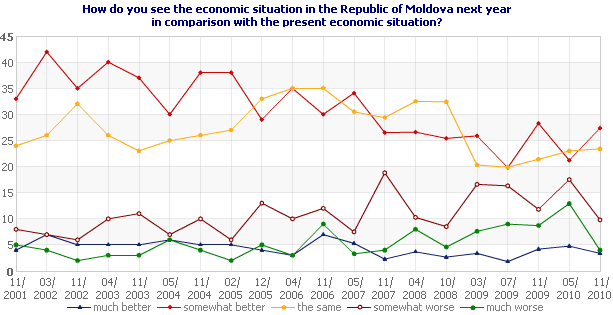
Individual earnings of respondents’ families were in the limits established long ago, though the number of those affording a decent living oscillates around 20%, while the number of those earning just enough to cover the strictly necessary is a little higher than 40%. The number of the very poor is constantly pretty high — approximately 30% (Table 5).
Table 5. How do you assess the current earnings of your family?
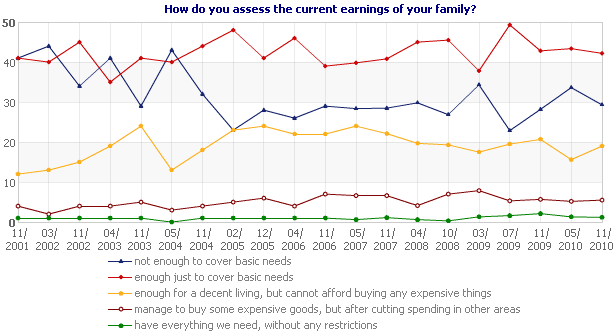
The concern with price rises is on the top again, with other three major concerns such as poverty, unemployment and children’s future being those revealed throughout years (Table 6).
Table 6. What are you currently concerned about the most?
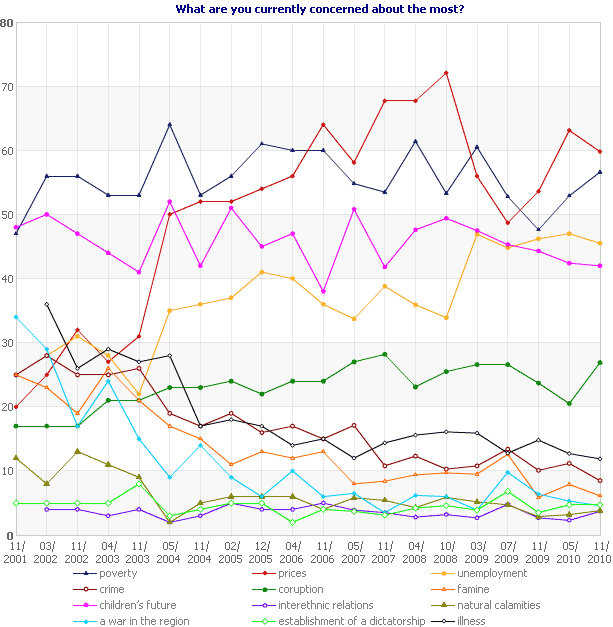
Priorities of citizens vs. Priorities of authorities
After the failure of presidential elections on December 7, 2009, the AEI components knew very well that their ruling is provisory, for approximately one year. In addition, they saw from BPO findings the priority expectations of citizens they should focus on — economic development, public order, anti-corruption fight and understanding between people (Table 7). Indeed, these were the priorities of the AEI-made pragmatic parties, while romantics focussed on historical truth, which influenced the rating of parties.
Table 7. How do you think, what are the most important tasks of the Republic of Moldova?
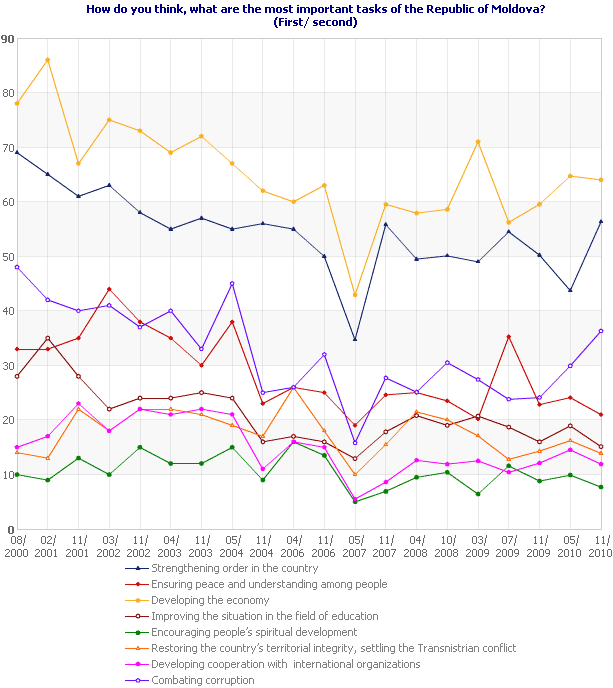
The conclusion above comes out from responses to the questions what should authorities do to improve the social-economic in the country (Table 8).
Table 8. What should be done to improve the social-economic situation in country?
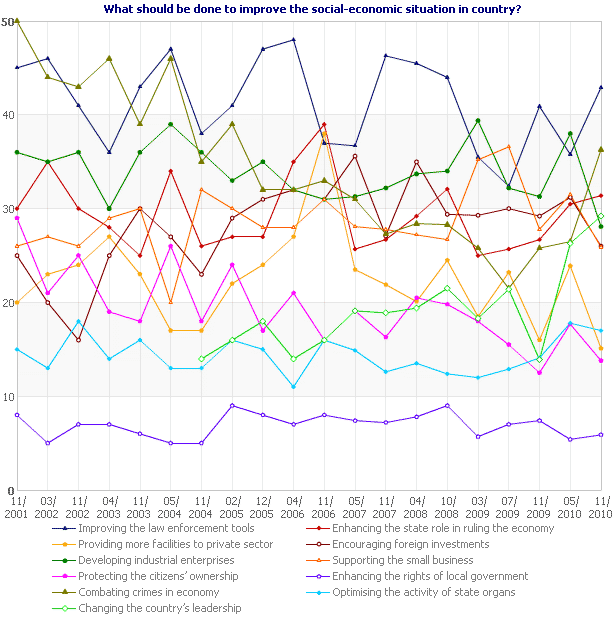
Confidence with institutions
The most dangerous thing for the AEI components is the dramatic fall of confidence with state institutions, revealed by Table 9. Confidence with the chief of state has declined the most. It reached the limit that once crossed the population started to be less confident with President and Parliament than with police and justice, which traditionally had a relatively bad image since the Soviet times. On this background, the Government looks better, a fact which influences the confidence rating of parties and politicians who rule it.
Table 9. How much do you trust in…
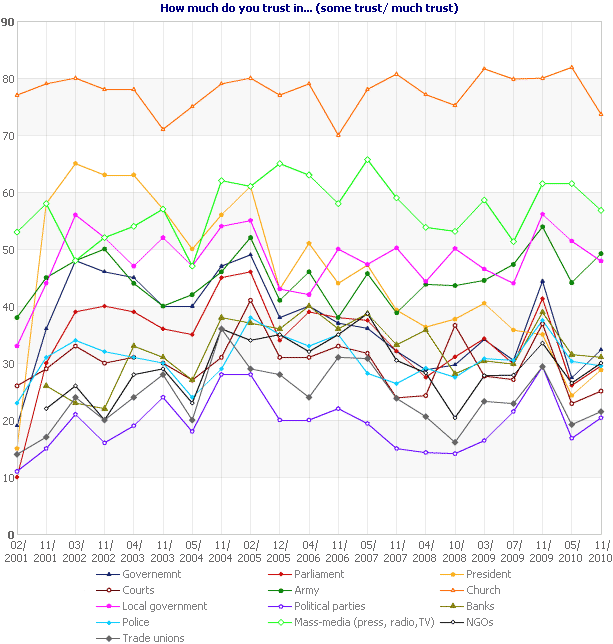
As well, the AIE should worry that more than half of respondents (54%) signalled that they do not feel free to protest against decisions of authorities, while more than 70% say that they cannot influence national decisions. In this context, it is understandable that 74% of respondents fear the Republic of Moldova is not ruled by people’s will, and 46% say that elections are not free and fair.
The only positive thing for the AEI is that respondents think that the Filat Cabinet ruled the country better (32.5%) than the Greceanii Cabinet (23.6%), but this thing should be regarded in the light of patriarchal political culture ruling in Moldova. There is an axiom that in countries with patriarchal political countries like Moldova the authorities who manage the least to maintain the social-economic situation on waterline enjoy the trust of people. Perhaps, this fact explains somehow the trust in the party which representative runs the cabinet of ministers.
Trust in parties and political leaders
The general perception of the state of things in the Republic of Moldova, as well as the trust in institutions correlates well enough with intentions to elect ruling and opposition parties. Therefore, the rating of the Liberal Democratic Party of Moldova (PLDM) leader, Vlad Filat, has increased much after being nominated prime minister in September 2009. Following an unimportant decline last spring, the ascending trend of the confidence rating of prime minister was reconfirmed. On the other hand, the rating of key opponents from the ruling alliance and opposition has decreased or stagnated (Table 10).
Table 10. How much do you trust in following political personalities?
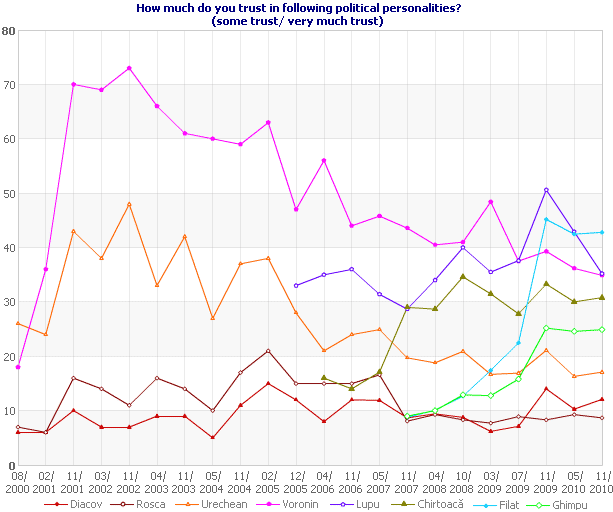
The evolution of answers to the open question on political personality enjoying trust is the best confirmation of this fact (Table 11). Really, responses to open questions are most relevant to estimate political support, as they involve personal effort of respondents in identifying the subject of preferences. In this regard, Premier Vlad Filat has become national political leader last year, as his political rating in responses to the open questions has constantly increased starting 2007 and defeated all other leaders in 2010. A clear rise was observed in the rating of Liberal Party (PL) chairman Mihai Ghimpu. Of course, this ascension is due to the office of interim president he is holding for about one year. However, one may suppose that his rating has increased due to the PL deputy chairman Dorin Chirtoaca, a PL animator who is now behind. The rise of Ghipmpu’s rating on background of the fall of Chirtoaca’s rating could mean that PL fails to attract new adherents. The rating of the PCRM leader Vladimir Voronin has stabilised, being almost constant the last year. Finally, after the failure to become chief of state, the chairman of the Democratic Party of Moldova (PDM), Marian Lupu, has decreased much, down to the starting position since before early parliamentary elections in July 2009.
Table 11. What political personality do you trust in?
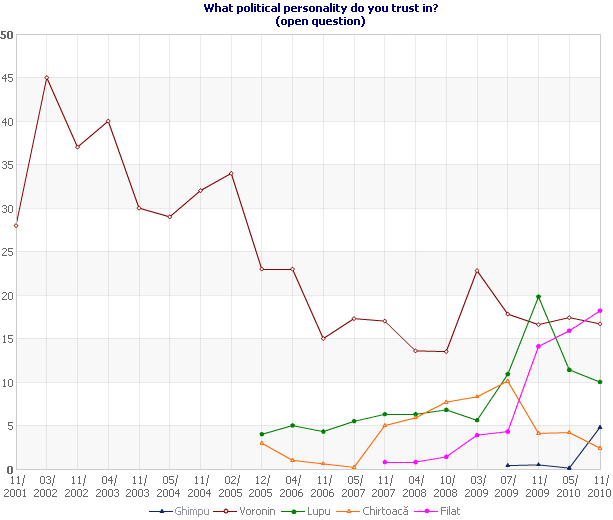
Table 12 reveals a very tight correlation between level of trust in leaders and their political parties. Trust rise or decline trends are probably linked to quality of campaigns held by parties.
Table 12. How much do you trust in the following political parties?
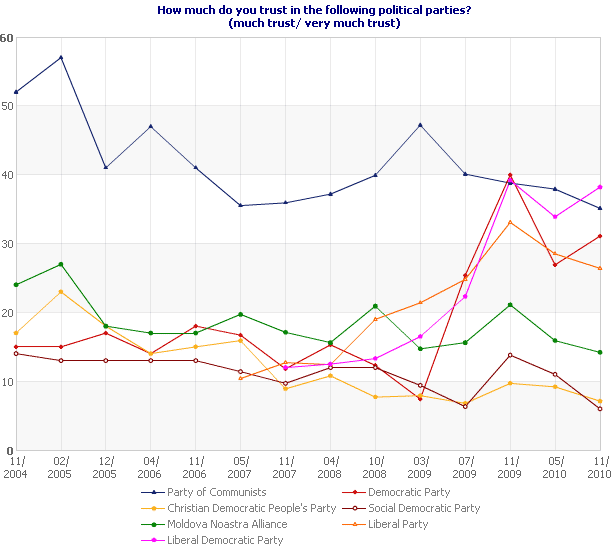
The conclusion above is also effective for answers related to intentions to elect (Table 13). Following more than one month of electoral campaign, the PLDM is quickly ascending and the PDM is recovering the ascending trend. It is normal, as both parties hold important financial and media resources. Following an important fall, the intention to elect the PL has stabilised, and a compensatory trend is observed. As for the PCRM, a decline is observed, as this party is in opposition.
Table 13. If elections to the Moldovan Parliament were held next Sunday, what party would you vote?
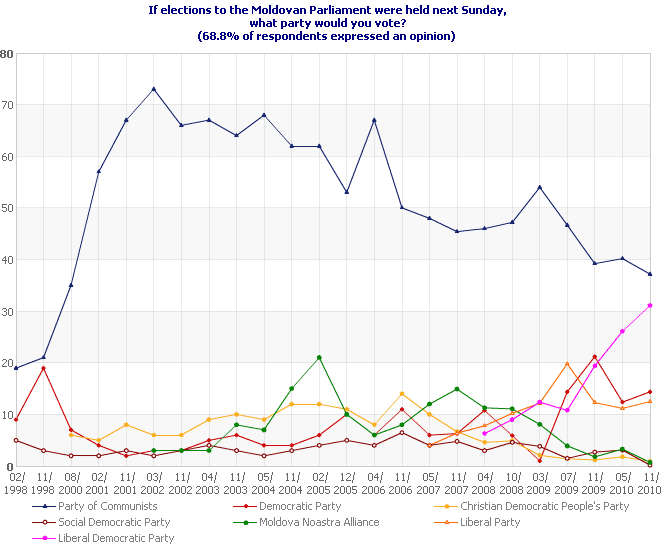
The previous experience revealed that these trends together with social optimism are implicit but very useful indicators to assess conduct of undecided electorate.
Conclusions
After a year of governing, the AEI succeeded to maintain the Republic of Moldova on the waterline. In general, though the disappointment of majority of people with the ruling act is visible, a poor manifestation of social optimism is observed and this could have a determinant effect on final results of early parliamentary elections;
After the electoral campaign is more than half completed, one may say that the social optimism would clearly advantage the PLDM, and this would mainly happen for account of other AEI components. It is clear for the time being that the AEI components per ensemble would be favoured in front of the No.1 opposition force — PCRM;
The PCRM positions seem to be weak because this party is in the opposition, but they were not affected dramatically. However, it seems that the PCRM speculations regarding anti-people actions do not produce the expected effect. Population carries too heavy burdens in the daily life to react to any PCRM insinuations;
The order of final results of key electoral candidates will be probably that indicated by BPO. The revealed trends suggest that the PCRM will probably get a final result capable to block the presidential elections, but not enough to build a one-colour government. Anyway, any surprise is possible, given the fact that disputes inside of AEI get new profile, and their impact cannot be estimated anymore.


